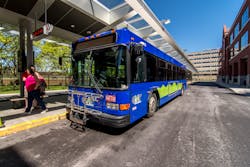Over the past year, a lot has been happening at Green Mountain Transit, the first and only transit authority in the state of Vermont.
In the fall of 2016, GMT underwent a massive rebranding effort to create a seamless brand across all GMT’s operating regions.
On October 13, 2016, GMT opened a new Downtown Transit Center in Burlington, Vermont. This state-of-the-art facility offers many passenger amenities that greatly improve the passenger experience. The building offers a comfortable heated/AC-cooled waiting area and restrooms. The new ticketing facility now offers expanded hours that are more in-line with service hours.
Outside on the boarding platform, radiant heaters have been placed to help keep passengers comfortable outdoors while waiting for their bus. The large glass roof offers protection from the elements, and glass wind barriers provide an added layer of protection in inclement weather.
Passenger Information
In an effort to improve passenger communication, information screens have been placed inside the DTC and along the boarding platform. GMT partners with local Burlington Telecom to offer free, gigabit-capable Wi-Fi throughout the entire facility.
In conjunction with the opening of the DTC, GMT launched a bus AVL system. Each GMT bus is equipped with a tablet and RouteMatch software. With the launch, transit vehicles are able to push real-time arrival times and schedule information directly to passenger mobile phones.
Passengers using RouteShout 2.0 are able to find information by specific stop, route, or schedule and if they are unsure of their exact location, there is a “Locate Me” feature that will use GPS to show the closest 10 transit stops. Users are able to make stops and locations “favorites” for quick access later.
In the fall of 2017, RouteMatch software on GMT transit vehicles will be able to “speak” to the bus bay signs at the DTC, better assisting passengers in locating their bus.
Plans for the Future
At the beginning of the year, GMT began a Comprehensive System Analysis for all five regions. The year—long study will help identify ways to better match service with current needs, make service simpler, more direct, faster and more convenient. It will also better integrate urban and rural services. This is the first time that GMT has conducted a comprehensive effort of this type.
A full assessment of the GMT fare structure will be conducted as part of the CSA. With advancements in mobile technology and farebox improvements, GMT could eventually provide a seamless regional fare option.
“I am always impressed by my staff at GMT,” said GMT General Manager Mark Sousa. “They are always bringing out-of-the-box ideas to the table, and their commitment to embrace technology helps move big projects forward. The future looks very bright for our agency.”
Jamie Smith is the marketing and public affairs manager at Green Mountain Transit.




